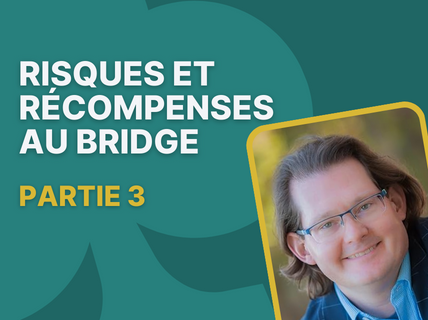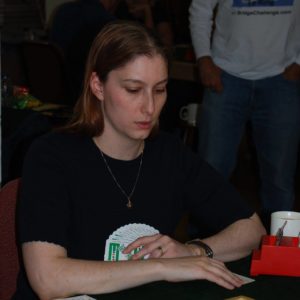



The EBU’s Schapiro Spring Fours has long been my favourite event in the English bridge calendar, so I am delighted to write about it here. Hopefully I will give you some insight as to how top players approach events like this, and if a few more teams enter next year, all the better! The reason I love this event so much is that, for me, it is the perfect combination of a serious, high-level tournament and a friendly, social one. Players often stay at the venue, which always seems to have a great bar, no matter where it’s hosted, so there’s always a good showing of people to chat to in the evening.
The Winter Games came just before Spring Fours - indeed, three members of the winning Winter Games team triumphed at Spring Fours too! My partner, Mike, was also playing in both events, which meant that our preparation for Spring Fours involved a lot of discussion of hands that he’d just seen in Tignes. This was helpful because I have a full-time job outside of bridge, and rely on discussing problem hands, and using Bridgemaster to get my brain into gear ahead of an event. It was also helpful for Mike because, as you will read later, talking about hands after an event is the best way to move on and mentally “re-set”.
We also put some time in to practicing our system. We use BBO bidding tables for this, as it’s possible to constrain deals, bid against bots, and move through hands quickly. I find reading system files very difficult and am very much a “learn by doing” sort of a person, so bidding a bunch of hands and talking through them is by far the easiest way for me to get my mind around how everything fits together.

The EBU relocated Spring Fours to Bristol this year, which I think was a great choice. The venue wasn’t completely perfect, although it was very good in many ways, but the city was beautiful and offered a wide variety of hotels and restaurants for all budgets and tastes. Finding good food is particularly important for me as I often find it hard to eat properly during events – I’m quite a nervous player, and I often lose my appetite until play ends each day. I like to snack between sets to keep my blood sugar up for this reason, and the increasing availability of healthy-ish cereal bars and energy balls has been a game-changer for me.
For me, another big part of playing well is feeling confident, and having the right partner and teammates makes a huge difference to this. Phil and Benjy, our teammates, were delightful – great dinner company and always keen to look at the hands, but never ones to dwell too long on mistakes. They also brought back some great cards, which always helps! Phil produced a beautiful one-suit squeeze on this deal:
click "NEXT" to see the play
The ♦10 was led and ducked all round, and West played a second diamond, which Phil ruffed. He now ran the ♣Q into East’s King. East played a third diamond, which declarer also ruffed (a spade would have been better but then the hand would have been much less interesting). Three rounds of trumps followed, and then Phil cashed the club suit. This was the position just before he cashed the last club:
When the ♣10 is played, West is stuck. If he throws the ♠6 declarer can just duck a spade. He will be forced to win it, all of his remaining spades being greater than partner’s ♠8, and is now endplayed to lead away from the ♠K. He must therefore throw a bigger spade: the jack or ten. Now, if declarer ducks a spade, East’s ♠8 will win and East can cash two diamond tricks.
At the table, West defended well and did indeed throw the ♠10, but this was not enough to save him. Phil played the ♠Q out of hand. West must cover this, and now declarer can duck. This leaves poor West on lead with ♠J6, with dummy holding ♠A7 over him. A very well-deserved make!
Another interesting board arose in a later set, where most tables got to 3NT by one way or another, and roughly half of the field made, and half went off:
The best lead for the defence is a heart, which was tougher for some tables to find than others, depending on the auction. How should declarer play on a heart lead?
All declarers now played the ♦K out of hand, which it’s very natural to duck as West. Taking it and playing another heart beats the contract on this layout, but declarer could make you look silly by holding ♦KJ or ♦KJx and needing the diamond suit to fetch. Once the ♦K has held, declarer has a few options. If the clubs are coming in, they have 9 tricks on top, but that will still be true if declarer faffs around in a side suit first, so there is no rush to test clubs.
On the actual layout you can make by playing a club to the Q and then a spade off the dummy. This requires both spade honours on-side, however, which is not likely. A better chance is to aim to run the diamonds.
On the surface it might feel like the right play in the diamond suit at this stage is low to the ten, but in fact the opposite is true. Playing low to the ten feels appealing because Kx facing QT98x resembles Kxx facing QT98x, where this is the right line after playing a diamond to the ♦K (whether it wins or not). They are, however, entirely different combinations – that third diamond in hand makes a huge difference!
Returning to the suit combination at the table, if the diamond suit is breaking 3-3 with both honours in the same hand, it does not matter what you do: you will either find that the suit is always coming in (both honours with West), or never doing so (both honours with East). If the honours are split in a 3-3 break, it’s a pure guess whether you play the Q or T on the second round of the suit. We hence ignore 3-3 breaks.
There are, however, 4-2 breaks where it does matter what you do. You can’t pick up AJxx on either side, but you can pick up a crucial honour doubleton: if East has ♦Jx you must play a diamond to the Queen, which is why this is the correct play. Note that if East has Ax diamond, playing one to the T will not save you – you want the whole suit to run, not just to score a second diamond trick. Roy Welland found this play at the table and was rightly rewarded: although the ♦J didn’t drop, the Queen held and a third round of diamonds now established the suit. Playing a suit from the top-ish to pick off a short jack is a theme that comes up fairly often in 7 card fits, or fits where you can’t finesse lots of times (e.g. a 7-1 fit), so this one is worth filing away.
Pretty much all bridge players that I know want to post-mortem hands after events are done. Our team did this to some extent every night, but Mike and I were also lucky to have a friend from a different team staying with us for a few days after Spring Fours came to an end, so we got to have both another perspective and another set of stories from him.
Going through hands with my partner after an event is important for me for a few reasons. Firstly, it lets me draw a line under it and move on. No matter how an event went I always come away feeling that there were a million things I could have done better, and this process helps me to look logically at what I did well and less well, and form a less emotionally driven sense of how I’m doing and what I need to work on moving forward.
It can also help me to notice patterns in my game, such as spots where I tend to make mistakes. These could be specific kinds of positions where I have a bit of a blind spot, but it could also be as simple as “I find it really hard to focus when there is noise around the table and I need to make an effort not to participate in chat between boards”.
A third benefit is that talking through hands can highlight areas where partnership agreements need work. It’s easy to feel, following a bad hand, that a piece of the system or a carding agreement is to blame, but talking through the hands a couple of days after they’ve been played can make it easier to see whether this is the case. Mike and I played Smith echoes in suit contracts as well as vs NT for some time, but have just thrown this out because we saw how many hands were tougher than they needed to be – this is the sort of thing that you only realise if you go through hands regularly, as there will be plenty of wins as well as losses, and if you only look at one session it’s hard to tell whether you are coming out ahead or not.
The fourth, and, in my view, greatest, benefit of going through hands, is that it builds partnership understanding and underscores a partnership dynamic in which my partner and I are a team. This can only be possible if post-mortems are genuinely open, supportive, and non-judgemental. Partners who bring no ego to post-mortems are worth their weight in gold, and someone who tries to use a post-mortem to assert authority or undermine their partner can do a lot of damage. Fortunately, I’ve found more people that fall into the first camp. It's best if you can, to surround yourself with people who genuinely love the game, and who you like outside of a bridge context.
Finally, and probably most importantly, always try to be the kind of person you would want to play and talk bridge with yourself.
Sarah Bell is a professional bridge player, writes a regular column in English Bridge and is a full time teacher. She represented England in their Mixed team and won a silver medal in the World Women's Pairs. She's served on the EBU's Laws and Ethics Committee and was founding chair of their Online Ethics Investigation Group.




Excellent , thank You Sarah ! Is Schapiro Spring Four Bridge Tournament named after Boris Schapiro? If yes, this is unfortunate name for the bridge tournament, as Boris Schapiro ( excellent player ), partnering famous Terence Reese ( excellent player and outstanding author of bridge books ) were involved in the 60-ties in so called Cheating Scandal, showing with their fingers how many hearts they hold. Neither of them admitted to cheating, but Boris Schapiro said once " Terence Reese forced me to use this system " not specifying if he meant this cheating system, or Little Major - super artificial, relayed bidding system invented by Terence Reese.
I found this really interesting with the comments on how the cards can break
In the first deal the best defend from East is to take first lead with Jack of Diamond and continue with 8 of spade...
Absolutely, but if he did that it wouldn't have been worth writing up any more😊. At the other table I led a low diamond so my partner had no choice but to win it and switch to a spade.
Excellent and so down to earth.